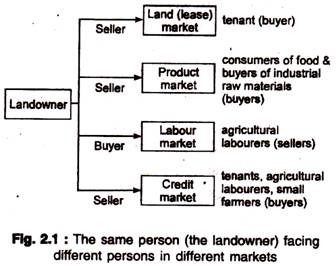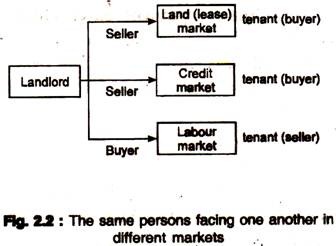Effect of Rural Markets on Indian Agriculture!
1. Land Market and Product Market:
In the land (lease) market, the landowner is the seller (of the use right of land) and gets rent in exchange.
Suppose, he receives rent not in cash, but in kind (as a portion of the output of land). He may consume a certain portion of his output and sell the surplus in the product market.
2. Land Market and Labour Market:
The landowner does not operate only in the land (lease) market. He may employ agricultural labourers at the existing wages. This means that he operates in the labour market also.
3. Land Market and Credit Market:
ADVERTISEMENTS:
Again, the landowner gives loans to the tenants or small farmers, or agricultural labourers hired by him. This means that he is operating in the credit market also.
Thus, the landowner operates in all four agricultural markets and in different capacities. In one market he is the buyer, in another he is the seller. See Fig. 2.1.
In this way, the presence of the same person in different markets is what is called interlocking of markets.
Two Effects:
ADVERTISEMENTS:
Due to interlocking of markets two things may happen:
1. The same person may face different individuals in different markets in different capacities.
2. The same two persons may face each other in different markets in different’ capacities.
Fig. 2.1 shows that in the land (lease) market the landowner as a seller faces the tenant who is. a buyer. But when the landowner sells his surplus output in the product market, he is a seller and buyers are consumer of food-grains and purchasers of industrial raw materials (factories).
ADVERTISEMENTS:
Again, when the landlord is operating in the labour market he is the buyer and the labourer is the seller who may or may not be either a tenant or a buyer of agricultural product which he sells. Thus, as Fig. 2.1 shows, when the landowner operates on one side in all markets, he may find different individuals on the other side in each such market.
It is also found, in reality, that the same pair of persons face each other in all four different (but inter-related) markets. See Fig. 2.2 in this context. It shows that the landowner faces the tenant in the land (lease) market. Again, when the same tenant borrows money from him (the landowner), the latter has to face the former in the credit market. In a like manner, when the same tenant is working under the landowner at the market wage, then the latter faces the former in the labour market as well. This is how the same two persons may face each other in different markets (in different roles, of course).

